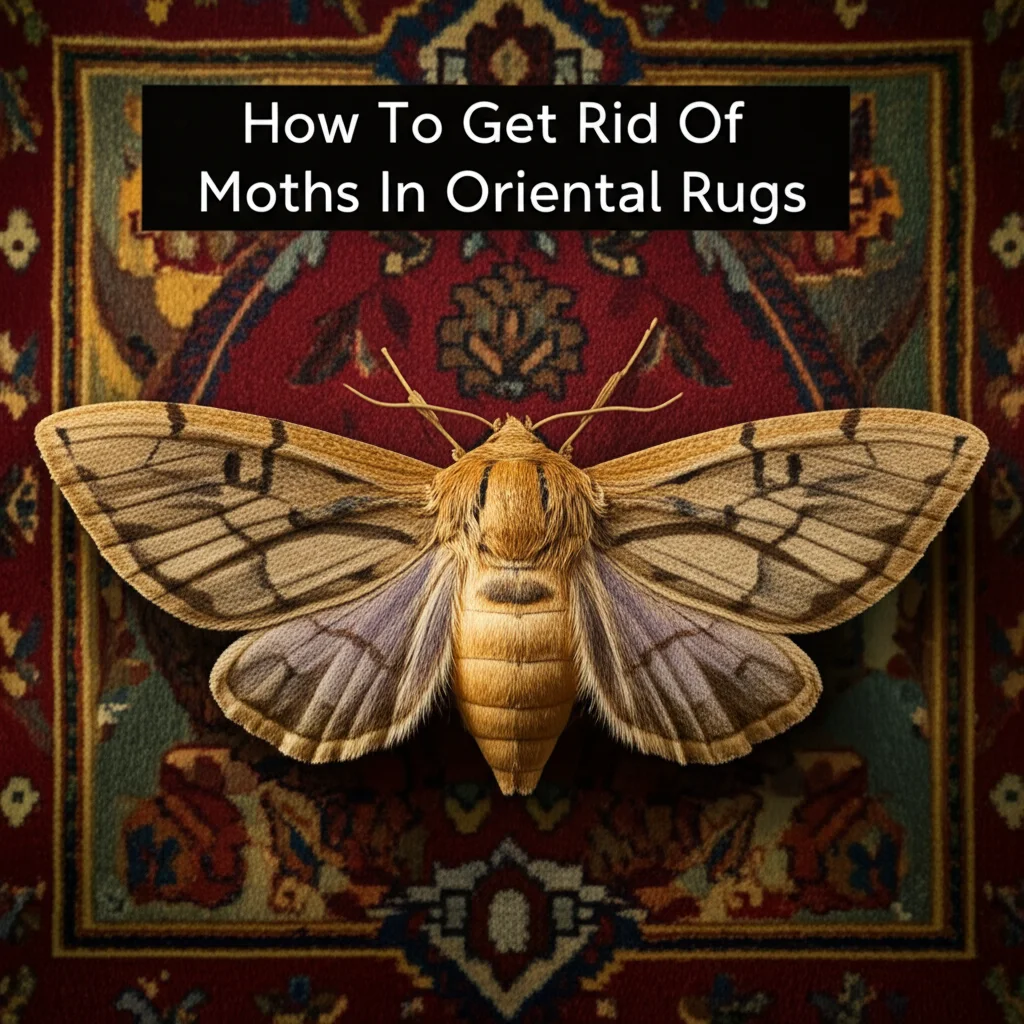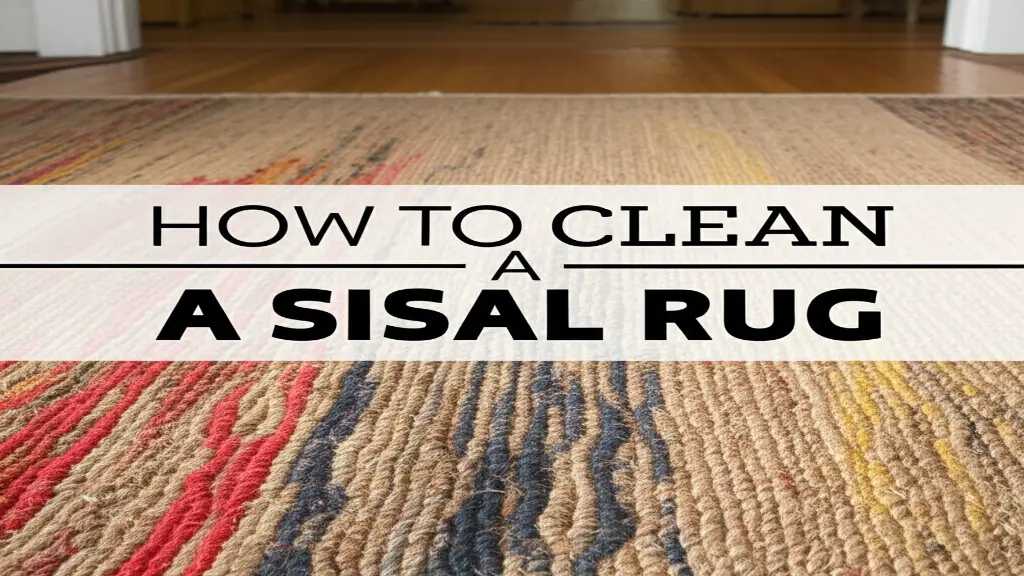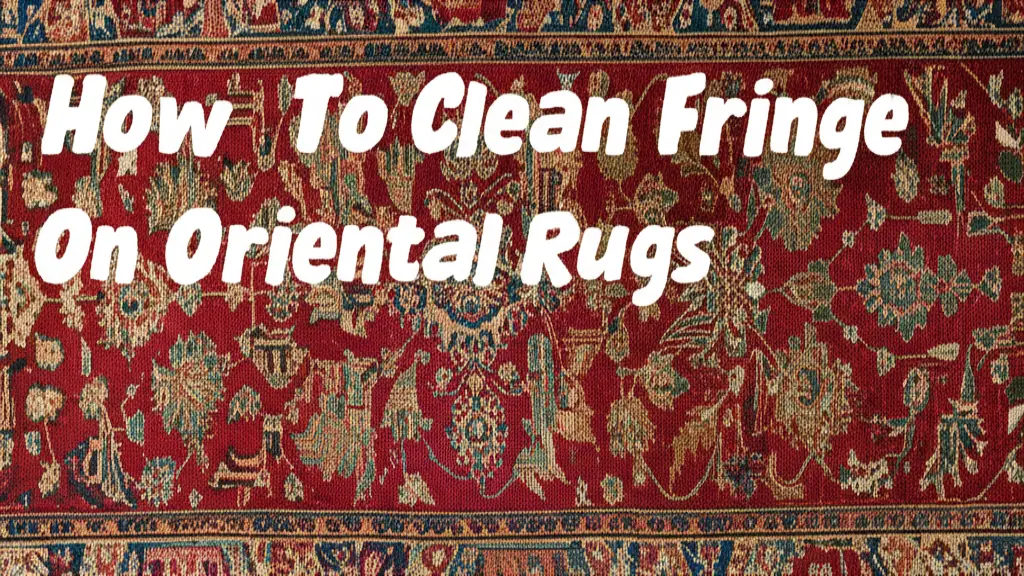· Todd Martin · Rug Cleaning · 17 min read
How To Get Rid Of Moths In Oriental Rugs

Key Takeaways
- Identify carpet moths by looking for damaged wool fibers, larvae, and cocoon casings
- Vacuum thoroughly, focusing on edges and underneath furniture before any treatment
- Use natural remedies like cedar, lavender, or vinegar for prevention and mild infestations
- Consider professional cleaning for valuable oriental rugs with significant moth damage
- Implement preventative measures including regular cleaning and moth repellents to protect your investment
Quick Answer: To get rid of moths in oriental rugs, thoroughly vacuum both sides of the rug, clean with appropriate solutions based on fiber type, use natural repellents like cedar or essential oils, consider freezing for severe infestations, and implement preventative measures including regular maintenance and proper storage techniques.
How to Identify a Moth Infestation in Your Oriental Rug
Before you can effectively tackle a moth problem, you need to confirm that moths are indeed the source of your rug’s damage. Early detection can make the difference between minor repairs and extensive restoration work, so it’s essential to know what signs to look for.
The most obvious indicator of a moth infestation is visible damage to your oriental rug. Look for irregular holes or bare patches where the pile has been eaten away, particularly in areas hidden under furniture or along edges where moths can feed undisturbed.
Unlike random wear patterns, moth damage typically appears in scattered, irregular patches throughout the rug.
Physical evidence of moths themselves provides conclusive proof of an infestation:
- Larvae: Small, cream-colored caterpillar-like grubs about 1/4 to 1/2 inch long
- Cocoon casings: Tiny, tube-like structures where larvae pupate before becoming adult moths
- Adult moths: Small, buff-colored insects approximately 1/4 to 1/2 inch in length
- Eggs: Minuscule white specks that are difficult to see without magnification
Another telltale sign is the presence of fine, sandy debris near damaged areas—this is frass, or waste material left behind by feeding larvae. You might also notice silky tunnels or webbing on the underside of your rug, particularly in corners and edges where moth larvae like to feed.
Pay special attention to areas that receive little foot traffic, as these undisturbed sections provide ideal breeding grounds for moths. Checking beneath furniture, along baseboards, and in closets where rugs might be stored is particularly important. Using a flashlight can help reveal larvae or cocoons that might otherwise blend into the rug’s pattern.
Don’t confuse natural wear with moth damage. While both may result in thinning pile, moth damage typically appears as irregular holes with rough edges, unlike the smooth wear patterns caused by foot traffic.
When in doubt, fold the rug back and examine the foundation—moths will often damage this structural component as well, which doesn’t occur with normal use.
Immediate Actions to Take When You Discover Moths
Discovering moths in your prized oriental rug requires swift action to prevent further damage. The moment you identify an infestation, implement these immediate steps to begin the eradication process.
Thorough Vacuuming
Your first line of defense is aggressive vacuuming. Use a powerful vacuum cleaner with strong suction to remove moths, larvae, eggs, and debris from both sides of the rug. Pay particular attention to:
- Edges and corners of the rug
- Areas under furniture
- The back of the rug where moths often lay eggs
- Areas showing visible damage
Make multiple passes over each section, working methodically across the entire surface. For best results, use a vacuum with a beater bar or brush attachment to dislodge deeply embedded larvae and eggs. Immediately dispose of the vacuum bag or empty the canister outdoors to prevent any survivors from reinfesting your home.
Isolate the Affected Rug
To prevent the infestation from spreading to other textiles in your home:
- Remove the rug from its current location
- Place it in a large plastic bag or wrap it in plastic sheeting
- Seal it tightly until you can begin treatment
- Inspect nearby rugs, carpets, and upholstered furniture for signs of moths
Remember that moths can easily spread from one textile item to another, so quick isolation is crucial to containing the problem.
Expose to Sunlight
Moths and their larvae thrive in dark, undisturbed environments and detest sunlight. On a warm, sunny day:
- Take the rug outdoors
- Hang it over a sturdy clothesline or railing
- Expose both sides to direct sunlight for several hours
- Beat the rug gently with a rug beater or broom to dislodge remaining pests
This simple treatment can be surprisingly effective for killing larvae near the surface and discouraging adult moths. The combination of UV rays, heat, and fresh air creates an inhospitable environment for these pests.
If weather doesn’t permit outdoor treatment, consider placing the rug in a sunny room indoors. While not as effective as direct outdoor exposure, even filtered sunlight through windows can help discourage moth activity while you prepare for more thorough treatment methods.
Natural and DIY Solutions for Moth Removal
If you prefer to avoid harsh chemicals in your home, several natural and DIY solutions can effectively combat moths in oriental rugs. These methods are particularly suitable for mild to moderate infestations and can be used as either primary treatments or as supplements to more aggressive approaches.
Vinegar Solution Treatment
White vinegar’s acidic properties make it lethal to moth eggs and larvae while being gentle on most rug fibers:
- Mix equal parts white vinegar and water in a spray bottle
- Test the solution on an inconspicuous area first to ensure it doesn’t affect colors
- Lightly mist the affected areas of your rug (avoid soaking)
- Allow the rug to dry completely in a well-ventilated area
The vinegar smell will dissipate as the rug dries, taking with it any lingering moth odors that might attract new pests. For particularly valuable or antique rugs, consult with a professional before applying any liquid solutions.
Essential Oil Treatments
Several essential oils contain compounds naturally repellent to moths:
- Lavender oil: Mix 20-30 drops with 1/4 cup water in a spray bottle
- Cedar oil: Combine 15-20 drops with 1/4 cup water
- Eucalyptus oil: Use 20-25 drops in 1/4 cup water
- Clove oil: Add 10-15 drops to 1/4 cup water (use sparingly as it’s potent)
Lightly mist these solutions onto your rug, focusing on areas showing signs of infestation. Always test on an inconspicuous area first and ensure proper ventilation during application. These oils not only kill moths on contact but leave behind a residual scent that continues to repel them.
Freeze Treatment
Cold temperatures effectively kill moths at all life stages without damaging rug fibers:
- Thoroughly clean the rug with a vacuum
- Fold or roll the rug, ensuring it will fit in your freezer
- Place the rug in a plastic bag and seal it tightly
- Put the bagged rug in the freezer at 0°F (-18°C) or below
- Keep it frozen for at least 72 hours
- Remove and allow to reach room temperature before unbagging
For larger rugs that won’t fit in a home freezer, consider commercial freezer services or consult with professional rug cleaners who often offer freezing as a moth treatment option.
Diatomaceous Earth Application
This natural powder consists of fossilized aquatic organisms and works by dehydrating insects that come into contact with it:
- Ensure the rug is completely dry
- Sprinkle food-grade diatomaceous earth lightly over the affected areas
- Work it gently into the pile with a soft brush
- Leave for 24-48 hours
- Vacuum thoroughly to remove the powder along with dead moths and larvae
Diatomaceous earth is non-toxic to humans and pets but extremely effective against insects. For best results, repeat this treatment weekly until no signs of moth activity remain.
Professional Treatment Options for Severe Infestations
When facing a severe moth infestation in your valuable oriental rug, professional intervention often becomes necessary. These experts have access to specialized treatments, equipment, and expertise that can effectively eliminate moths while preserving your rug’s integrity.
Professional Rug Cleaning Services
Specialized rug cleaning facilities offer several advantages over DIY approaches:
- Immersion washing: This thorough cleaning method removes moths at all life stages along with the food sources (skin cells, hair, etc.) that attract them.
- Centrifugal drying: Professional equipment extracts moisture quickly, preventing secondary issues like mildew or dye bleeding.
- Inspection expertise: Trained professionals can identify the full extent of the infestation, including areas you might miss.
Reputable rug cleaning services typically charge between $3-$8 per square foot for oriental rugs, with additional fees for moth treatment. While this represents a significant investment, it’s often worthwhile for valuable or antique pieces. Many cleaning companies also provide repair services for areas already damaged by moths, helping to restore your rug’s appearance and structural integrity.
Heat Treatment
Professional heat treatment involves exposing your rug to controlled high temperatures:
- The rug is placed in a specialized chamber or tent structure
- Temperature is raised to 120-130°F (49-54°C)
- This temperature is maintained for several hours
- The rug is thoroughly inspected and cleaned afterward
This method kills moths at all life stages without chemicals and can penetrate deep into the rug’s pile and foundation. The controlled environment prevents damage that might occur with amateur heating attempts. Heat treatment typically costs $150-$300 depending on rug size, but effectively addresses even severe infestations.
Chemical Treatments
For persistent infestations, professional-grade insecticides may be necessary:
- Pyrethrin-based treatments: Derived from chrysanthemum flowers, these are effective yet relatively low in toxicity
- Growth regulators: These prevent larvae from maturing into reproductive adults
- Residual insecticides: These provide ongoing protection against reinfestation
Professional application ensures these substances are used safely and effectively. After treatment, the cleaning company should provide instructions for when it’s safe to return the rug to your home and any precautions to take.
Professional Restoration
For valuable rugs with significant moth damage, restoration services can:
- Reweave damaged areas to match the original pattern
- Replace compromised foundation threads
- Restore pile height in affected sections
- Reinforce weakened edges and corners
While costly (often $100+ per hour of work), professional restoration can save a cherished or valuable rug that might otherwise be a total loss. For antique or collectible rugs, the investment in proper restoration often preserves both monetary and sentimental value.
Preventative Measures to Keep Moths Away
After successfully eliminating moths from your oriental rug, implementing preventative strategies is crucial to avoid future infestations. These protective measures require minimal effort but can save you significant time, money, and heartache down the road.
Regular Maintenance Routine
Consistent cleaning disrupts the moth lifecycle and removes the organic matter that attracts these pests:
- Weekly vacuuming: Vacuum both sides of your rug at least once weekly, paying special attention to areas under furniture and along edges.
- Rotate your rug: Every 6-12 months, rotate your oriental rug 180 degrees to ensure even wear and prevent moths from establishing in less disturbed areas.
- Professional cleaning: Schedule professional cleaning every 1-3 years depending on foot traffic and location.
- Sunlight exposure: Periodically taking your rug outside for sunning (avoiding direct sun on vibrant colors) naturally deters moths through UV exposure.
Remember that moths thrive in undisturbed environments, so simply moving and cleaning your rug regularly significantly reduces the likelihood of infestation.
Natural Moth Repellents
Several natural substances effectively repel moths without harsh chemicals:
- Cedar products: Place cedar blocks, chips, or oil near your rugs or in storage containers. Replace or refresh them every 3-6 months as the scent fades.
- Lavender sachets: Place sachets containing dried lavender around your home and directly on stored rugs.
- Herbs and spices: Packets containing cloves, rosemary, thyme, or bay leaves serve as natural deterrents.
- Essential oil diffusers: Regularly diffuse cedar, lavender, or eucalyptus oils in rooms with oriental rugs.
For maximum effectiveness, combine several of these natural repellents and refresh them regularly as their scents diminish over time.
Proper Storage Techniques
When storing oriental rugs, proper techniques prevent moth infestations:
- Clean thoroughly before storage
- Wrap in breathable cotton or muslin cloth, never plastic which traps moisture
- Add cedar blocks or lavender sachets inside the wrapped rug
- Store in a cool, dry location with stable temperature
- Check stored rugs quarterly for signs of moths
- Consider commercial storage facilities specialized in textile preservation for long-term storage
If using rug storage tubes, ensure they’re made of acid-free materials and include moth deterrents before rolling the clean, dry rug for storage. Even during storage periods, unwrap and inspect rugs at least twice yearly to catch any problems early.
Environmental Controls
Moths thrive in specific conditions that you can modify to make your home less hospitable:
- Humidity control: Maintain indoor humidity below 50% using dehumidifiers in damp areas.
- Temperature management: Keep rooms with valuable rugs cool when possible, as moths prefer warm environments.
- Light exposure: Increase natural light in areas with oriental rugs, as moths prefer darkness.
- Regular inspections: Check behind furniture and under rarely moved items monthly for signs of moth activity.
These environmental controls not only discourage moths but create better conditions for preserving the natural fibers in your oriental rugs, extending their beauty and lifespan for generations to come.
Repairing Moth Damage in Oriental Rugs
Even with prompt intervention, moths can cause damage that requires repair to restore your oriental rug’s beauty and integrity. Understanding your repair options helps you make informed decisions about addressing moth damage in these valuable textiles.
Assessing Damage Severity
Before attempting repairs, carefully evaluate the extent of moth damage:
- Surface damage: If only the pile is affected without foundation damage, repairs are relatively straightforward
- Structural damage: When moths have compromised the foundation warps and wefts, professional intervention becomes necessary
- Pattern impact: Damage in highly visible pattern areas requires more skilled repair than damage in monochromatic or less noticeable sections
Use a magnifying glass to examine damaged areas closely, gently bending the rug to check if foundation threads remain intact. Take clear, well-lit photographs of damaged areas to share with professionals when seeking repair quotes.
DIY Repair Options for Minor Damage
For minor surface damage, some repairs can be attempted at home:
- Trimming: Carefully snip away loose, damaged fibers with small scissors
- Spot cleaning: Remove any remaining moth residue with a mild soap solution
- Fiber blending: For small bare patches, carefully take matching fibers from the rug’s edge or hem and attach them with fabric glue
- Edge binding: Reinforce damaged edges with special carpet binding tape
These DIY approaches are best suited for small, inconspicuous damage in less valuable rugs. For significant damage or valuable oriental rugs, professional repair is strongly recommended.
Professional Repair Services
Professional rug repair specialists offer several restoration techniques for moth damage:
- Reweaving: Skilled artisans can reweave damaged areas to match the original pattern, replacing both pile and foundation fibers
- Reknotting: For hand-knotted oriental rugs, specialists can tie new knots to replace damaged pile
- Patching: In some cases, a small section from an inconspicuous area (like under furniture) can be used to patch a damaged visible area
- Foundation repair: When structural threads are compromised, specialists can reinforce or replace them
Professional repairs typically cost $100-$300 per square foot of damaged area, depending on the rug’s complexity and the damage severity. While expensive, professional restoration can return valuable rugs to near-original condition, preserving both their aesthetic appeal and monetary value.
When to Replace Rather Than Repair
In some situations, replacement may be more practical than repair:
- Extensive damage: When more than 25-30% of the rug is severely damaged
- Foundation collapse: If large sections of the structural foundation have been destroyed
- Repair costs exceeding value: When repair estimates approach or exceed the rug’s replacement value
- Sentimental value: Even heavily damaged rugs with high sentimental value may warrant repair despite cost
Consult with multiple professional restorers before deciding to replace a damaged oriental rug. Sometimes, creative solutions like converting a damaged larger rug into a smaller piece can preserve portions of a treasured item that might otherwise be lost.
FAQ: Common Questions About Moths in Oriental Rugs
Can moth damaged rugs be repaired?
Yes, moth damaged oriental rugs can be repaired in most cases. Minor damage limited to the surface pile can be addressed through reweaving or reknotting techniques. More severe damage affecting the rug’s foundation requires professional restoration by specialists experienced with oriental rugs. The repair success depends on damage extent, rug type, and the repairer’s skill level. While repairs can be costly, ranging from $100-$300 per square foot of damaged area, they’re often worthwhile for valuable or sentimental pieces.
Does vacuuming kill carpet moths?
Vacuuming alone doesn’t kill all carpet moths but plays a crucial role in moth control. It removes adult moths, larvae, and eggs from accessible areas of your rug, significantly reducing infestation levels. For maximum effectiveness, use a vacuum with strong suction and a beater bar attachment, focusing on both sides of the rug and paying special attention to edges, corners, and areas under furniture. While vacuuming is an essential first step, it typically needs to be combined with other treatments for complete moth elimination.
How do I protect my rug from moths?
Protect oriental rugs from moths through consistent preventative measures: vacuum weekly, rotate rugs biannually, and schedule professional cleaning every 1-3 years. Use natural repellents like cedar, lavender, or rosemary around your rugs and in storage areas. Maintain low humidity levels (under 50%) and provide good air circulation. When storing rugs, clean them thoroughly first, wrap in breathable cotton cloth (never plastic), and include cedar products or herb sachets as deterrents. Regular inspection of rugs, especially in dark areas and under furniture, helps catch infestations early.
How do I know if I have carpet moths?
Identify carpet moths by looking for their distinctive signs: irregular holes or bare patches in wool or silk areas of your oriental rug; cream-colored larvae (about 1/4 inch long) feeding in the pile; small, buff-colored adult moths fluttering near the rug at night; silky tubes or webbing on the rug’s underside; and fine, sand-like debris near damaged areas (moth frass). Check dark, undisturbed areas like under furniture or along walls where moths prefer to feed. Unlike normal wear patterns, moth damage appears as scattered, irregular holes rather than in high-traffic areas.
What’s the best moth spray for oriental rugs?
For oriental rugs, the most effective and safe moth sprays contain permethrin or pyrethrin, which target moths while being relatively gentle on natural fibers. Products specifically labeled for use on wool, such as Moth Guard or Kleen Free, offer good results. For a natural alternative, consider essential oil-based sprays containing cedar, lavender, or eucalyptus oils. Always test any spray on an inconspicuous area first to ensure it doesn’t damage colors or fibers. For valuable antique rugs, consult with a professional before applying any spray treatments.
How long does it take to get rid of carpet moths?
Eliminating carpet moths from oriental rugs typically takes 2-6 weeks with consistent treatment. The timeline depends on infestation severity, treatment methods used, and how thoroughly you address all life stages (eggs, larvae, pupae, and adults). Quick removal requires a multi-pronged approach: thorough vacuuming, appropriate treatments (chemical, heat, freezing, or natural remedies), and ongoing preventative measures. Complete eradication is confirmed when you observe no new damage, adult moths, or larvae for at least one month. Persistent or returning infestations often indicate missed eggs or larvae in hidden areas.
Are professional treatments worth the cost?
Professional moth treatments for oriental rugs are generally worth the cost, especially for valuable, antique, or sentimental pieces. Professional services offer comprehensive solutions including specialized cleaning methods, controlled heat treatments, and appropriate insecticides applied by trained technicians. They can also provide repairs for existing damage and preventative treatments against reinfestation. While costs typically range from $100-$500 depending on rug size and infestation severity, professional treatment often proves more economical long-term than repeated DIY attempts or potentially having to replace a ruined rug.
Final Thoughts: Protecting Your Investment
Oriental rugs represent not just beautiful home decor but often significant financial and sentimental investments. These handcrafted pieces frequently incorporate generations of artistic tradition and craftsmanship, making their protection from moth damage all the more important.
The key to long-term success in keeping moths at bay lies in consistent, proactive maintenance rather than reactive treatments. By incorporating regular cleaning, rotation, and inspection into your household routine, you create an environment where moths struggle to establish themselves. Remember that prevention is always less costly and less stressful than dealing with an established infestation.
Consider creating a simple calendar reminder system for rug maintenance tasks—weekly vacuuming, monthly inspections, biannual rotation, and professional cleaning every few years. This systematic approach ensures nothing falls through the cracks in your protection strategy. For particularly valuable rugs, documenting your maintenance activities can even help maintain their provenance and value.
Related Articles
How to Clean Fringe on Oriental Rugs
How to Identify Antique Persian Rugs





